Bago is an important station on the double-track route from Yangon via Naypyitaw to Mandalay. It is also the junction for the single line to the south of Myanmar. Originally, this single line line terminated at Mottama but, with the opening of the Thanlwin Bridge, there is now a continuous railway to Mawlamyine and beyond.
At Bago there are two fully-interlocked mechanical signal cabins, one at each end of the station (South Cabin at Yangon end, North Cabin at Mandalay end) and a number of parallel loops through the station. I had previously seen a similar arrangement in use at Kyee Myin Daing (see the report of my visit to Kyee Myin Daing on 10th May 2017 here.
The Doctor and I arrived at Bago station at 1.00 p.m. and were ushered into the spacious meeting room. After introductions to Yin Min Oo, the Assistant Divisional Manager, the Signal Officer and two others who would accompany us on our tour, one of whom was an English speaker, we set off on our tour.
On the platform, we passed a particularly battered specimen of an Arrivals and Departures board. This board helps passengers find their correct coach, by showing the make-up of major passenger trains. Each coach is represented by a disc with vehicle details inscribed. The appropriate discs are hung on a horizontal series of small hooks so that the composition of each train is readily visible. Three trains are shown - I assume the apparent gaps in the train formation indicated are because of broken or missing hooks.
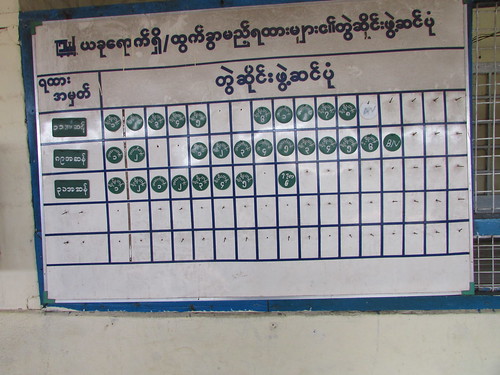
A particularly battered Arrivals and Departures board at Bago
Station Master's Office
The office which directs and authorises traffic movements in the Bago area they referred to as the 'Station Master's Office'. I think Myanma Railways may also use the term 'Sub-Control' for the more important locations.

Bago track diagram in Stationmaster's Office
Click for larger image
The Sub-controller (as I will provisionally call him) updates the train register book and writes out and issues the paper 'Line Clear' forms authorising train movements. The Sub-controller also has a radio, which links him with the Control Office in Yangon, and an impressive array of desk telephones. There's a hand-cranked magneto telephone which I think communicates with the Bago Signal Cabins and five auto telephones whose function I didn't discover.

The 'Sub-controller' in the Station Master's Office at Bago
At the 'Sub-controller' desks at Bago, there are two elderly items of electrical signalling equipment similar to those I'd seen on an official visit to Kyee Myin Daing in 2017 (described here). I assumed that, as at Kyee Myin Daing, they are used to instruct the two local signal boxes regarding the route through the station area to be taken by trains. There's also a third, similar instrument which I think is not in use.

Route Indicating Signalling Equipment, Bago (The Railway at Bago, 9th May 2018)
Each instrument is housed in a substantial, cast housing rather similar to some designs of electric token instrument, with the cast cover secured with a padlock. All indications and controls are on the front face. There are two 2-position galvanometers towards the top; one a lower-quadrant semaphore stop signal indicator, the other displaying text in a slot (ON/OFF, as far as I can determine). Below this is a window showing part of a rotating disc revealing different numbers, according to the angular position of the disc which is controlled by turning a commutator knob below the window. I've found displays of 'N', '1' and '3' so I assume this is how the desired road is selected. Near the bottom of the front is a substantial pull-out slide (rather similar to that on certain electric tablet machines). To the left of the slide, is a push-button (possibly to reset for the next route).
These instruments are connected electrically to the appropriate signal cabin, where the required route is visually indicated.
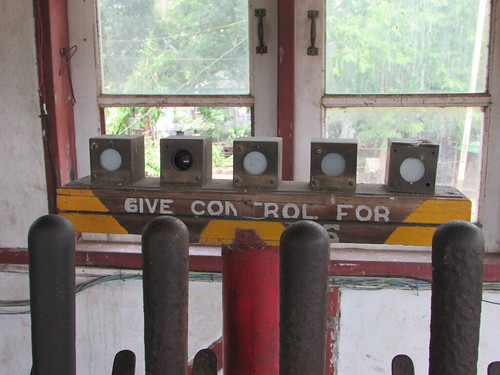
These 'GIVE CONTROL FOR' filamentary indicators in the signal cabin show the required route (The Railway at Bago, 9th May 2018).
Time didn't allow me to get to the bottom of this tantalising puzzle, so I'm afraid I still have only a hazy understanding of the set-up as our hosts were anxious to move on to the signal cabin at the Mandalay end of the station, Bago North.
I was keen to see the mechanical signalling at Bago at close quarters as it's to be abolished and all the delightful semaphore signals removed as part of the railway modernisation. My interest had been whetted travelling through Bago by train on 8th September 2012 during an uncomfortable journey from Yangon to Kyaikto, described in two posts here and here. Three days later, I returned to Yangon by road, stopping at Bago to add more photographs of the railway.
As we walked across the multiple tracks from the main platform to reach Bago North Signal Cabin, I kept stopping to take pictures of items of signalling equipment, including an example of one of the rather elegant ground disc signals.

One of the rather simple yet elegant ground disc signals at Bago (The Railway at Bago, 9th May 2018)
Bago North Signal Cabin
We entered the mechanical signal cabin of Bago North where, on the operating floor, two signalmen were on duty.

Bago North Cabin, overall view (The Railway at Bago, 9th May 2018)

Track Diagram, Bago North Cabin (The Railway at Bago, 9th May 2018)
Click for larger version
I photographed everything in sight for later study and the young signalman set up a route to demonstrate the operation of the levers (but I didn't ask to try myself). I asked to see the locking room and, again, took a number of photographs.
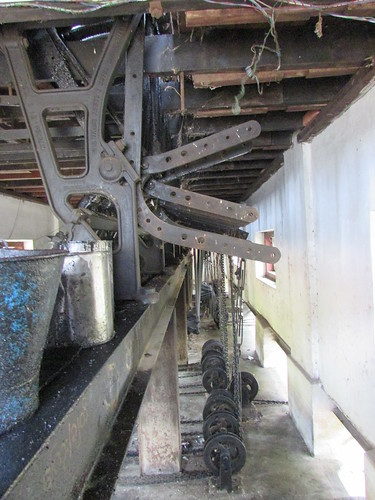
Bago North Signal Cabin: General view of locking room (The Railway at Bago, 9th May 2018)

Bago North Signal Cabin: Locking room, showing drive from levers to inclined locking tray (The Railway at Bago, 9th May 2018)

Bago North Signal Cabin: Locking room, showing detail of inclined locking tray (The Railway at Bago, 9th May 2018)
For more information on the control of trains in Myanmar, see the post here Alternately, there's an index of all my Myanma Railways posts (which may not always be up-to-date) here.
Bago Locomotive Depot
On 6th May 2015, I'd made a visit to Insein Locomotive Works in Yangon (described here) and was excited to find them restoring a couple of steam locomotives with the intention of using them to operate tourist trains. That didn't happen but the German travel firm FarRail Tours stepped in to support the costs and use the locomotives for photographic charters. I took a few pictures of the restoration work in progress which you can find here.
I knew from following the interesting FarRail Trip Reports that the three serviceable steam locomotives were normally kept in the shed at Bago. During the 2018 Bago visit being described, our hosts offered a visit to the locomotive shed so, of course, I quickly agreed. Any loco depot is full of interest and I quickly took a few pictures showing the office block with the sign for the Loco Ispector's Office (in English and Myanmar languages), a couple of Japanese 'RBE' diesel railcars, a single-ended Very Lightweight Diesel Railcar carrying the running number LRBE66, locomotive DF1205 (a 1200 h.p. Bo-Bo-Bo diesel electric but with single cab and very worn paint finish). There was a 'graveyard' of dismantled steam locomotives including a number of main frames with cylinders attached, a bogie, coupled wheelsets in two sizes and I don't know what else was hidden in the undergrowth.
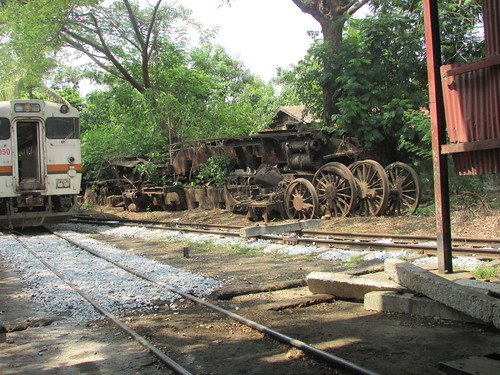
Japanese diesel railcar and 'graveyard' of dismantled steam locomotives (The Railway at Bago, 9th May 2018)
The original massive water tower survives. There are also three modern elevated, rectangular tanks. I think the left one is water - the others may be diesel fuel which I didn't confirm but they are ajjacent to three 3,500 gallon cylindrical fuel tanks, silver-painted and mounted horizontally. Nearby are two of the original inspection pits and a water column supplied by J. Blakeborough and Sons, Brighouse in 1904.

DF1205, original water tower, storage tanks, inspection pits and water column (The Railway at Bago, 9th May 2018)
I'd previously tracked down various non-operational examples of steam in Burma at various locations (there's a post here) but this was my first sighting of engines still steamable so I clambered onto the footplate of each of the three locomotives in turn, grabbing as many pictures as I could before our hosts became too restless.
The three locomotives are from two classes produced after World War II to allow Burma Railways to recover from severe war damage (at different stages during the war, Burma was bombed by both the the U.K. and Japan). Vulcan Foundry at Newton-le-Willows was involved in the building of these classes. There's a splendid website chronicling the history of Vulcan Foundry here.
One 'YB' class 4-6-2 for passenger service is preserved and two 'YD' class 2-8-2 mixed traffic locomotives. All three are oil-fired although, when withdrawn, some examples of these classes remained coal-fired.
The solitary 'Pacific' type, 'YB629' was standing outside the north end of the shed, coupled head-to-head onto 2-8-2 'YD964' which was the engine I'd identified under heavy repair at Insein back in 2015. At Bago, 'YD964' was standing over the Wheel Drop with the motion partly taken-down, presumably in need of running repairs. The second 2-8-2 was standing outside the south end of the shed. My pictures of these three survivors are in the album here, and I apologise for the poor quality of some of them in my haste to record as much as possible.

'YB629' 4-6-2 outside Bago Shed (The Railway at Bago, 9th May 2018)
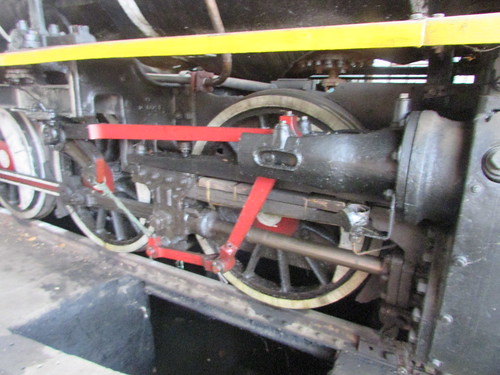
YD 964': View of driver's side showing partly-dismantled motion. Wood between the slidebars prevents the crosshead from moving. The locomotive is standing over the Wheel Drop (The Railway at Bago, 9th May 2018)

'YD967' 2-8-2 at Bago: For once, Jan looks quite happy (The Railway at Bago, 9th May 2018)
Bago to Yangon by Train
When our hosts managed to prise me away from the steam locomotives, I was all set for a visit to Bago South cabin but they said there was not enough time, so we made our way back to the station, this time using a public footbridge. However, they did suggest that I might like to return to Yangon by train, a suggestion I readily accepted. Train 32 from Naypyitaw (from where it departed at 08:00) was due to arrive, they said, at 15:00. They also suggested that my photographic opportunities might be better in an Ordinary Class coach, where all the windows were sure to be fully open, rather than an Upper Class coach. I agreed with their reasoning and a ticket was issued. Then they said the train was 15 minutes late and it actually arrived about 15:20. According to the rail travel website 'The Man in Seat 61' here, the train was not due in until 15:20 and was due to depart at 15:23, arriving Yangon at 17:00. Well, we left about 15:23 and cracked along at what, for a Burmese train, was a a very good speed. We made just one stop and arrived at Yangon Central Station at 17:00. The journey is described in some detail in the post Bago - Yangon by train.
Related posts on this website
This is one of a series of posts describing Myanma Railways.
Selecting label 'Myanma-Railways' or clicking here displays all the posts with this label in reverse date-of-posting order.
Alternately, there is an Index here (but it may not be always quite up-to-date).
My pictures
Where necessary, clicking on an image above will display an 'uncropped' view or, alternately, pictures may be selected, viewed or downloaded, in various sizes, from the albums below:-
Bago Station (earlier pictures).
The Railway at Bago, 9th May 2018.
Bago to Yangon by Train, 9th May 2018.
All my Myanma Railways pictures.
